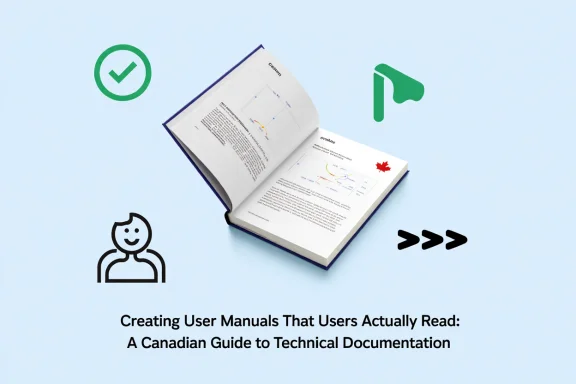
Creating User Manuals That Users Actually Read
Let’s be honest, eh – how many user manuals have you tossed aside faster than a soggy Tim Hortons donut? If you’re like most Canadians, the answer is “pretty much all of them.” From coast to coast to coast, we’ve all struggled with manuals that read like they were written by robots for other robots.
But here’s the thing – when done right, user manuals can be game-changers. They reduce support calls, boost customer satisfaction, and save your business money. Whether you’re a Halifax tech startup or a Vancouver manufacturing company, creating manuals that people actually use is crucial for success.
Why Most User Manuals Fail Like the Leafs in Playoffs
Before we dive into solutions, let’s understand why most manuals end up gathering dust. According to research from Canadian usability experts, 68% of users abandon manuals within the first five minutes due to:
Poor Organization: Information scattered like leaves in a Maritime windstorm Technical Jargon: Language so complex it makes tax forms look simple Terrible Design: Walls of text that would make even a policy wonk weep Missing Context: Steps that assume users are mind readers
The result? Frustrated customers, increased support costs, and products sitting unused. One Toronto-based appliance company found that 40% of their customer service calls could have been prevented with better documentation.
The Canadian Approach to Clear Communication
Here in Canada, we value straightforward communication – no beating around the bush, just honest, helpful information. Apply this same philosophy to your user manuals:
Start with Your Users’ Real Needs
Before writing a single word, understand who’s using your product. Are they busy Prairie farmers who need quick answers? Tech-savvy Torontonians? Senior citizens in Victoria trying new gadgets?
Research Your Audience:
- Survey existing customers about their pain points
- Monitor customer service calls for common questions
- Test your product with real users and observe their struggles
One Winnipeg software company reduced support tickets by 45% simply by reorganizing their manual based on actual user workflows rather than product features.
Structure Like a Good Canadian Road Trip
Just as you wouldn’t start a cross-Canada journey without a map, don’t write manuals without clear structure:
The Getting Started Section should be like entering Canada through customs – quick, efficient, and reassuring. Cover:
- What’s in the box (with actual pictures, not sketchy diagrams)
- Basic setup in under 15 minutes
- First successful use within 30 minutes
Progressive Disclosure works like exploring Canada – start with the main attractions, then dive deeper:
- Essential functions first (like finding the nearest Timmies)
- Advanced features second (like discovering hidden gem restaurants)
- Troubleshooting last (your roadside assistance)
Write Like You’re Explaining to Your Neighbour
Canadians appreciate plain speaking. Write your manuals the same way you’d explain something to your neighbour over the fence:
Use Active Voice: “Press the red button” not “The red button should be pressed” Choose Simple Words: “Use” instead of “utilize,” “help” instead of “facilitate” Keep Sentences Short: Aim for 15-20 words maximum Add Context: Explain why users need to do something, not just what to do
For example, instead of “Initialize the calibration protocol,” try “Press ‘Start Setup’ to help your device learn your preferences (takes about 2 minutes).”
Visual Design That Works in Canadian Conditions
Whether your manual will be read in a bright Calgary office or a dimly lit Nunavut workshop, design matters:
Make It Scannable
Most users scan before they read – design for this reality:
- Headings every 3-4 paragraphs: Like highway signs, they guide the journey
- Bullet points: Break up dense information
- White space: Give content room to breathe like a Prairie landscape
- Consistent formatting: Create visual patterns users can follow
Use Visuals That Actually Help
Pictures speak louder than words, especially for complex tasks:
Screenshots Should Be Current: Nothing frustrates users like outdated interfaces Annotations Matter: Circle, arrow, or highlight the important parts Step-by-Step Visuals: Show the before, during, and after states Real Photos Over Illustrations: Actual product shots build confidence
A Montreal tech company increased task completion rates by 60% when they replaced generic icons with actual photographs of their product interfaces.
Testing and Improvement – The Canadian Way
Like any good Canadian, continuously improve your manuals through feedback:
Test with Real Humans
Before launching, test your manual with actual users:
- Time them completing key tasks
- Note where they hesitate or get confused
- Ask follow-up questions about clarity
- Observe their body language (frustration shows)
Create Feedback Loops
Make it easy for users to suggest improvements:
- Add feedback forms at the end of sections
- Monitor customer service for recurring issues
- Update content regularly based on real user experiences
- Thank users who provide helpful feedback
The Bottom Line: Manuals That Serve Canadians
Creating user manuals that people actually read isn’t rocket science – it’s about respect. Respect for your users’ time, intelligence, and real-world situations. When you write with empathy, organize with logic, and design with purpose, you create documentation that truly serves.
Remember: every frustrated customer who can’t figure out your product is a potential lost relationship. But every user who successfully completes a task thanks to clear documentation becomes a brand advocate.
Start implementing these techniques in your next manual project. Your customers will thank you, your support team will appreciate the reduced call volume, and your bottom line will reflect the improved user experience.
Ready to transform your technical documentation from paperweight to powerhouse? Begin with one small manual, apply these principles, and measure the results. You might be surprised how much difference clear, Canadian-friendly communication makes.